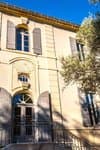
Petit et Gros Calans
The Calans, emblematic of the northern facade of the Alpilles, offer you their imposing reliefs. After passing the Badon Arboretum, be surprised by a geology and breathtaking views.
11 points of interest
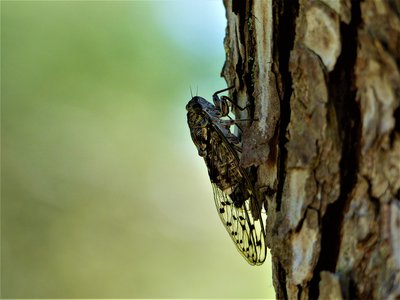
Cigale sur un pin d'Alep - ©Rémi Sérange - PNR Alpilles  Fauna
FaunaThe cicadas song
The cicada is a brown insect measuring 5 to 9 cm in length. It has a rigid proboscis called rostrum, which it plants in roots and plants to feed themselves. It has four long transparent wings. As soon as the temperature is sufficiently high (about 25°C), the male cymbalise (" sings") to attract the females of the same species. While the larvae can live for several years underground, the adult lives only 2 months in the summer to reproduce.

Arboretum du Badon - ©Rémi Sérange - PNR Alpilles  Flora
FloraBadon Arboretum
An old quarry became discharge, it is in 2009 that this one was rehabilitated to revalue this remarkable site in the middle of Alpilles. This project of revaluation goes through the creation of an arboretum, a space of Mediterranean flora adapted to the climate. From 2010, the first trees are planted by the students of the vocational agricultural school of Saint-Rémy-de-Provence. About sixty trees and many shrubs represent the floristic diversity of the scrubland.
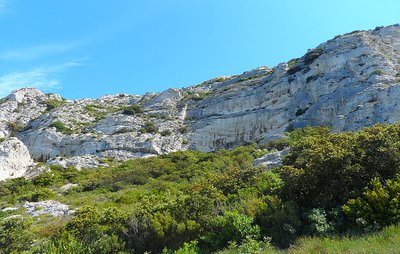
Formation géologique du Gros Calan - ©Jason Gaydier - PNR Alpilles  Geology
GeologyCalans
A Calan is a hard limestone escarpment formed between 160 and 90 million years BC. These cliffs are the remains of an ocean presence in distress. Indeed, the Tethys ocean was here during the Jurassic period, the same period that saw the water level decrease. It was then that massifs such as the Alpilles ridges or as the calans were formed. Here, you can distinguish the Gros and Petit Calan because of their size.

Point de vue du gros Calan et du piémont Nord - ©Jason Gaydier - PNR Alpilles  Panorama
PanoramaAn island in the middle of nowhere
From this viewpoint, you will have the chance to make a brief stop and admire the beauty of the Alpilles. On your right you have the Gros Calan and the Chaîne des Alpilles in the distance. These massifs are the result of tectonic plate movements and the action of the formerly present ocean millions of years ago. Today they are home to flora and fauna that are now the wealth of these places.
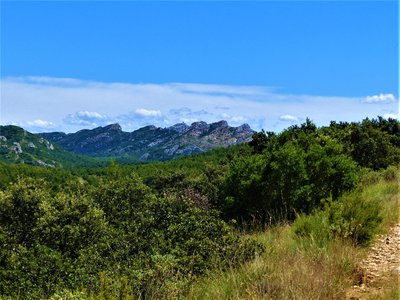
Vue sur les Civadières - ©Rémi Sérange - PNR Alpilles  Peak
PeakView of the top of the Opies
If you look up, you will see the Opies massif. This massif, a bit away from the Alpilles, is characterized by a series of ridges where the highest point is located in the territory of the Park: the Opies, at 498m of altitude. From the lookout tower which symbolizes the summit, you can see up to the Alpine peaks! Nevertheless and despite its imposing presence, this massif is fragile and it is advisable to roam other peaks capable of receiving visitors.
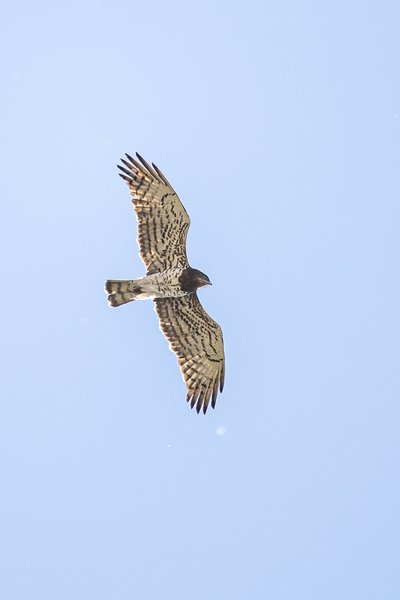
Circaëte Jean-le-Blanc - ©David Tatin  Fauna
FaunaShort-toed snake eagle
Returning from the Sahara for the summer period, the short-toed snake eagle Jean-in-the-blank, Circaetus gallicus, is a raptor with a wingspan of 1.80 m and he can weigh up to 2 kilos. He has the top of the brown wings and the white underside. Its body is dotted with colorful spots, colour and density depending on the individual (between light beige and dark brown). It hovers for a long time in the manner of vultures to hunt its prey, mainly reptiles!
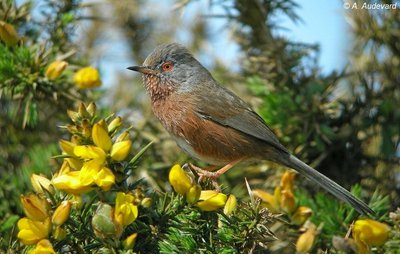
Fauvette pitchou - ©Aurélien Audevard - LPO  Fauna
FaunaThe Dartford warbler
If you see the Kermes oak trees around you, keep an eye out, and the right one! As you could probably see the Dartford Warbler, characterized by its eye circled in red, fond of Kermes oaks. This species has little adaptability, making it dependent on the Mediterranean natural environment and vegetation of low altitude and high density. An insect-eating bird, it also seems to feed on plant material during the harshest season. Do not disturb it!

Point de vue sur Eygalières - ©Anne-Catherine Privat-Madelin - PNR Alpilles  Panorama
PanoramaView of Eygalières
The village of Eygalières as well as the ruins of the castle at its summit, are the last vestiges of the castrum of Aigueria, of which the first writings date back to the 13th century. The village was originally built on a small rocky ridge, allowing its inhabitants to protect themselves against possible attacks, before expanding on the surroundings. The name of Eygalières is closely linked to water, as indicates its Latin name "Aquilaria" or in Provencal "Eigaliero".

Petit Calan - ©Rémi Sérange - PNR Alpilles  Geology
GeologyLe Petit Calan
The Petit Calan, like the Gros Calan, finds its origin from the Barremian. Its rocks formed with the deposition and compression of the remains of organisms living in a shallow sea about 160 million years ago. They gained altitude by constituting a rock ensemble, undergoing fractures and foldings of lesser amplitude. This elevation of the Alpilles chain is directly related to the rapprochement between the Eurasian and African tectonic plates.
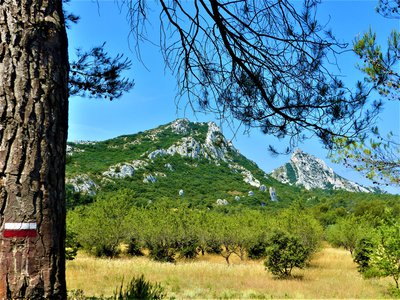
Calan de Rousset - ©Rémi Sérange - PNR Alpilles  Geology
GeologyThe Calans
A calan is a hard limestone cliffs that formed between 160 and 90 million years BC. These cliffs are the vestiges of an oceanic presence. Indeed, the Thétys Ocean was here during the Jurassic period, the same period that saw the water level decrease. It was then that massifs, like the crests of the Alpilles, or like the calans, were formed. The most famous are the Calan de Rousset, the Petit Calan and the Gros Calan.
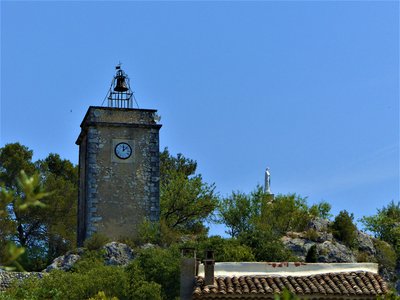
Tour de l'Horloge et statue de la vierge Marie - ©Rémi Sérange - PNR Alpilles  Patrimony and history
Patrimony and historyView of the clock tower
Built in 1672 with stones from the castle, the Clock Tower is the symbol of the independence of Eygalières. In 1660, the villagers paid the ransom of their lord, the Duke of Guise, taken hostage by the Spaniards. As a reward, they won the seigniorial rights of their village. Next to the 13th century dungeon, there remains only the vaulted ground floor. The Virgin statue was placed on the roof in 1893 to commemorate a miracle, and always seems to watch over the village.
Description
From the parking, follow the D24b towards the city center. At the crossroads, turn right. Then leave the town hall on the left. 50 m further, leave the Monument to the dead on the left and continue along the road.
1- Turn left on the path Ludovic Souvestre, and take the first right. Cross the locality of the 4 vents and continue on the path. Once at the Badon Arboretum, go around it on the left and follow the trail. 200 m after the barrier, take the small rocky path on the left.
2- At the directional sign "Balade du Gros Calan", turn left and follow the massif on the stony path. In the bend, continue on the path, leaving the small path on the left.
3- Go past the green tank in the hairpin bend, then turn right immediately onto the gently sloping trail at the concrete tank. Follow it to the junction with the D25.
4- Cross the departmental and take the path on the right in the pine forest. Then walk along the road for 350 meters (Caution, traffic!). Leave the road after the turn to take the wide path that goes on the right. Continue for 200 meters until you reach a fork, then go right up the path that continues towards the hill. Follow this zig-zag path for 1.5 km.
5- Engage in the small path that sinks to the right of the path. The latter leads to a new trail. Leave the different paths that leave from both sides to join the D25. Cross it again. Then climb the main path after crossing the barrier.
6- At the height of the tank, continue straight on the track which descends gently. After the bend, take the left path at the next junction. Follow this path along the Petit Calan then continue in the forest.
7- Cross the barrier and take the small path on the right that runs along the road for about 700 m. Turn right at the crossroads, and continue on the path. Go past the well and continue on the main road to the D24b.
8- Cross the departmental road and continue on Mario Prassinos road. Go behind the cemetery and enter Eygalières. At the top of the small hill, turn right. Possibility to fork then directly to the parking lot or to walk in the village.
- Departure : Stadium parking, Eygalières
- Arrival : Eygalières
- Towns crossed : Eygalières and Aureille
Forecast
Altimetric profile
Recommandations
Information desks
House of the Alpilles Regional Nature Park
2, boulevard Marceau, 13210 Saint-Rémy-de-Provence
Located in the heart of the city centre of Saint-Rémy-de-Provence, the House of the Alpilles Nature Park welcomes you to its completely renovated premises. This new vibrant place is multifunctional: it accommodates the Park's engineering team but also has a public reception space and showrooms. A true resource centre of the Park's heritage, it aims to support and promote locals, visitors and tourists on all 16 municipalities of the Park.
Open Monday to Friday, from 9 am at 12:30 pm and from 1:30 pm to 5 pm.
Free admission.
OTI Alpilles-en-Provence
Place Jean Jaurès, 13210 Saint-Rémy-de-Provence
Transport
Access and parking
Parking :
Report a problem or an error
If you have found an error on this page or if you have noticed any problems during your hike, please report them to us here:

